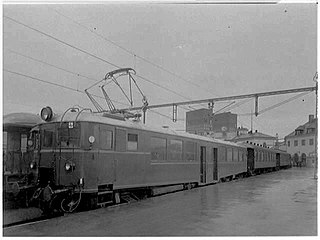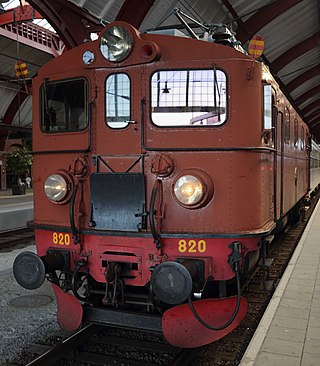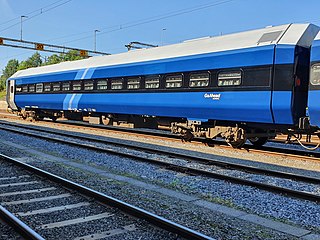
SJ is a government-owned passenger train operator in Sweden. SJ was created in 2001, out of the public transport division of Statens Järnvägar, when the former government agency was divided into six separate government-owned limited companies. In 2018, SJ carried 31.8 million passengers.

X 2000, also called SJ X2 or simply as X2, is an electric tilting train operated by SJ in Sweden. It was constructed by Kalmar Verkstad in Kalmar, Sweden and launched in 1990 as a first-class only train with a meal included in the ticket price, and free use of the train's fax machine. There is a bistro on board that serves snack bar-style dishes. From 1995 second class was introduced. All trains are equipped with Wi-Fi for passenger access to the Internet and were repainted grey as of 2005. The trains also have electric power supply sockets at all seats in both first and second class. The trains have been fitted with repeaters to improve mobile phone reception.

The Glasgow Subway is an underground light metro system in Glasgow, Scotland. Opened on 14 December 1896, it is the third-oldest underground rail transit system in Europe after the London Underground and the Budapest Metro. It is also one of the very few railways in the world with a track running gauge of 4 ft wide. Originally a cable railway, the subway was later electrified, but the double-track circular line was never expanded. The line was originally known as the Glasgow District Subway, and was later renamed Glasgow Subway Railway. In 1936 it was renamed the Glasgow Underground. Despite this rebranding, many Glaswegians continued to refer to the network as "the Subway". In 2003, the name "Subway" was officially readopted by its operator, the Strathclyde Partnership for Transport (SPT).

The Harris trains were the first steel-bodied Electric Multiple Unit train to operate on the suburban railway network of Melbourne, Victoria, Australia. They were introduced in 1956, by the Victorian Railways, and last operated in 1988, although a number of the carriages were converted for other uses and are still operating. They were named after Norman Charles Harris, Chairman of Commissioners of the Victorian Railways, between 1940 and 1950.

Class 70 is a four-carriage electric multiple unit operated by Vy on medium distance trains around Oslo. They are operated on the Dovre Line between Oslo and Lillehammer / Dombås and on the Vestfold Line, operating the regional service between Lillehammer and Larvik / Skien.
There are three basic types of Norwegian railway carriage used commonly by NSB on the Norwegian railway system, the Class 3, Class 5 and Class 7 series. As of 2005, the carriages are hauled by NSB El 18 engines on the main electrified stretches and NSB Di 4 engines on non-electrified lines.

Corail is the name given to a class of passenger rail cars of the SNCF that first entered commercial service in 1975. When introduced, the Corail carriages had improved passenger comfort, featured air-conditioning, and better levels of suspension and sound-proofing compared with previous InterCity carriages.
Strømmens Værksted A/S was an industrial company based in Skedsmo, Norway, specialising in the production of rolling stock. Founded in 1873, it remains as a part of Bombardier Transportation. The plant is located just off Hovedbanen west of Strømmen Station.

NSB Class 65 was a three-car electric multiple unit operated by the Norwegian State Railways between 1936 and 1985. It was mainly used for local trains as well as branch lines. A total of 49 units were delivered between 1936 and 1949. The motor cars were built by Norsk Elektrisk & Brown Boveri and Skabo while the centre and end cars were built by Strømmen.

Da is a series of locomotives used by Swedish State Railways. 93 units were built by ASEA between 1952 and 1957. They remained in service until the 1990s.

The NZR 56-foot carriage is a class of 56 ft (17 m) long railway passenger carriage formerly used on almost all long-distance passenger rail transport in New Zealand. 88 carriages have been preserved.

NSB Class 5 or B5 is a series of passenger carriages built by Strømmens Værksted for the Norwegian State Railways. Built between 1977 and 1981, they went through a major upgrade between 2008 and 2012. Sixty-three units were delivered. Each is 25.30 metres long, 3.10 metres wide, and 4.075 metres tall. They weigh 42 tonnes and have a maximum permitted speed of 160 kilometres per hour (99 mph). They are used predominantly on the Dovre Line, the Nordland Line and the Vestfold Line.

The English Electric Balloon is a type of double-decker tram that is operated on the Blackpool Tramway. Initially brought into service in 1934, the Balloon formed the backbone of the Blackpool tram fleet until the tramway's conversion to a modern light rail network in 2012. Following the network's re-opening, nine Balloons were converted to meet the disability regulations to serve as a supplement to the modern Flexity 2 vehicles. Some of the Balloons have been retained for use within the heritage fleet.

The RUB type carriage stock was a type of steel bodied air conditioned passenger carriage operated by the New South Wales Government Railways from September 1949 until April 2000.
This article is intended as a catalogue of sleeping carriages used by the Victorian Railways and successors.

NSB WLAB-2 or WLAB2 is a class of twenty sleeping cars built by Strømmens Verksted for the Norwegian State Railways (NSB). They serve as the sole sleepers in Norway, being used on the Bergen Line, Dovre Line, Nordland Line and Sørlandet Line. Each car features fifteen compartments, which can each be utilized with a single or twin bunk configuration. The carriages have a unique octagonal shape, are 27 meters long and weigh 48 tonnes.

V&SAR Intercolonial Express Carriages were carriages on a new train called the Intercolonial Express running on Victorian Railways and South Australian Railways in 1887. The track of two railways met on Wednesday 19 January 1887. The Victorian Railways' Western Line to Dimboola, and the South Australian Railways' Wolseley line, met at Serviceton. Since both sides shared the broad gauge of 5'3", an agreement was made between the two railways allowing a pool of carriages, classed O, to be specifically allocated to interstate trains linking the capitals of Melbourne and Adelaide. The operating and maintenance cost of the new train would be funded by both railways, approximately 60% paid for by the Victorian Railways and 40% by the South Australian Railways.

The A class of the Swedish State Railways (SJ) was a type of steam locomotive built in 1906–1909 for hauling mainline express trains. The 26 locomotives were built to replace older types that could not cope with the increasingly heavy express trains, but soon became insufficient themselves. They were relegated to less important passenger trains, and five were transferred to then-independent Ostkustbanan (OKB) in the 1920s, but returned when that company was nationalized in 1933.
AB7 is a Swedish passenger car of the 1980s-cars featuring both first and second class seating. In 2008 SJ decided to refurbish and modify some of their carriages originally built in the 1980s. As a part of the modernization program in 2009-2010, SJ rebuilt all of their AB9 carriages to a more modern version, designated the AB7. The main difference is that the smoking section of the carriages were removed. The carriages feature an open saloon as the seating area, as well as 230 V power outlets and 4 restrooms in each carriage with 2 in each end.















